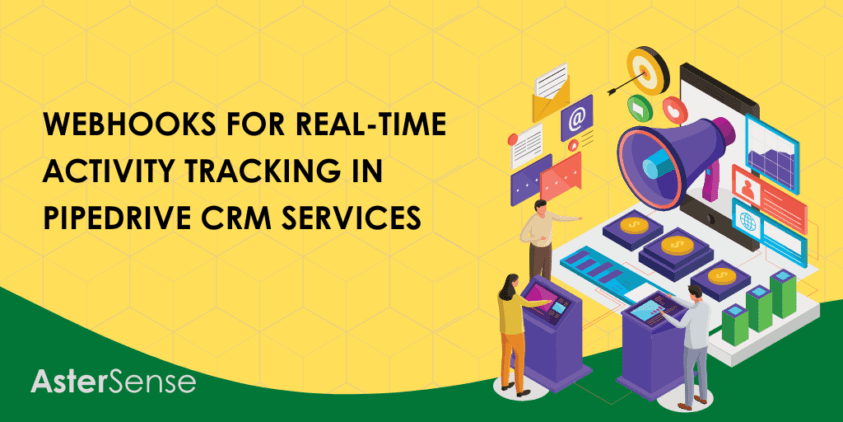What if your CRM services could whisper every important update directly into your team’s ear the instant it happens?
Timely insights are critical to driving successful sales outcomes. With CRM services like Pipedrive, integrating webhooks allows your team to receive instant updates as activities happen, helping you stay proactive, not reactive.
In this blog, we’ll explain webhooks and why they’re vital for real-time tracking and show you two effective ways to set them up.
What Is a Webhook in CRM Services?
Webhooks are simple URLs (Uniform Resource Locators) designed to accept a POST request with structured data. They allow applications to send real-time data to other services when specific events are triggered.
For example, when a new order is placed, a webhook can instantly notify your CRM or messaging app. Webhooks use HTTP (mainly GET and POST) to transfer information between systems.
Once the trigger condition is met, the system packages the data and sends it off to the target endpoint. This makes webhooks an efficient and cost-effective solution to bridge platforms, whether you’re syncing CRMs, sending customer updates, or firing internal alerts.
How Pipedrive Uses Webhooks for Real-Time Tracking
Pipedrive offers webhook support that allows you to subscribe to events like:
New lead or contact creation
Deal updates and pipeline changes
Task completions or note additions
Email status updates (opened, clicked)
Activity scheduling or deletion
When any of these actions occur, Pipedrive instantly pushes the data to your chosen URL endpoint. This lets you update dashboards, notify team members, or even trigger personalised workflows as things happen.
Webhooks vs APIs: What’s the Difference?
Many people confuse APIs and webhooks, but they work differently.
Webhooks work with APIs but are often used for real-time alerts, while APIs are better suited for data retrieval and updates.
Prerequisites Before You Start
Before you start setting up webhooks in Pipedrive CRM, ensure you meet the following prerequisites:
An active Pipedrive CRM account.
Admin access to set up integrations.
A destination endpoint to receive the webhook data.
Two Ways to Set Up Webhooks in Pipedrive CRM Services
Now, let’s break down two practical ways to implement webhook integration within your CRM services using Pipedrive.
Method 1: Set Up Pipedrive Webhooks Integration Manually
For those who prefer more control over their integration or wish to test webhook flows before committing to full automation, manual webhook integration in Pipedrive is a great option. This method is ideal for developers or teams with internal systems.
Step 1: Create a Webhook in Pipedrive
Log in to your Pipedrive account.
Go to Settings → Tools and Apps → Tools → Webhooks.
Click “Create New Webhook.”
Fill in the necessary details:
Event Action: Select the action that triggers the webhook (e.g., “added” or “updated”).
Event Object: Choose the type of data you want to track (e.g., deal, person, or organisation).
Permission Level: Leave as default unless you require specific user restrictions.
Step 2: Add an Endpoint to Receive the Data
Open Webhook Tester in a separate browser tab.
Copy the unique URL provided (this will be your temporary test address).
Paste this URL into the Endpoint URL field in Pipedrive.
Leave the username and password fields empty.
Click Save to activate the webhook.
Step 3: Test Your Webhook
In Pipedrive, click the “+” button at the top and add a new Organisation.
Fill in the details and click Save.
Switch to the webhook tester, and you’ll see a message with the data sent from Pipedrive.
Bonus Tip: Use a tool like RequestBin or Webhook.site to test your endpoint responses.
Method 2: Simplify Pipedrive Webhooks Integration Using Astersense
Astersense offers a hassle-free, fully automated solution to set up Pipedrive Webhooks Integration, explicitly designed for teams that want to skip the technical complexity and focus on high-impact business outcomes.
With Astersense, you can effortlessly capture real-time data from Pipedrive events—such as new deals, updated contacts, or completed activities—and route it to your chosen platforms for instant action or analytics, all without writing a single line of code.
Why Choose Astersense for Pipedrive Webhooks?
Minimal Setup: No need for technical expertise. Astersense streamlines the process, enabling seamless integration with just a few clicks, making it perfect for sales and marketing teams with limited development resources.
Reliable and Secure Data Flow: Built on a robust and fault-tolerant architecture, Astersense ensures the reliable delivery of data from Pipedrive to your destination systems without data loss.
Tailored for CRM Services: Unlike generic platforms, Astersense is specifically designed for Pipedrive, offering optimised workflows and native support for key CRM events.
Custom Integration Solutions: Need something unique? Astersense allows you to create custom workflows, whether it’s sending Slack alerts, automating lead assignments, or syncing with marketing platforms.
30-Day Free Trial: Astersense offers a 30-day risk-free trial, allowing you to explore how easy CRM automation can be.
Exceptional Support: Astersense provides 24/7 customer support via chat, email, and scheduled calls, ensuring you never feel left in the dark.
Conclusion
The manual and automated methods for setting up Pipedrive webhooks have their advantages. The manual setup offers full control over the webhook flow, making it a suitable choice for developers or teams needing custom configurations.
However, for those looking for a quicker, code-free experience, Astersense simplifies the entire process, enabling businesses to streamline their CRM workflows without technical headaches.
Start your 30-day free trial today and see how easy CRM automation can be, enabling faster, smarter business decisions with Pipedrive webhooks.








